Welcome to FISH FOOD TIMES
Dec. 2016 issue No.156


Whitefin trevally usutsukuri sashimi
Extremely delicious fish
The standard Japanese name for this fish is said to be called Kaiwari. However, since the name is not exactly the same, I decided to express it with the local name Hiraji.
Until now the author has also called this fish called Mettki, not Hiraaji. In the case of Mettki, it refers to the case of a small size, Hiraaji has done a way of dividing it as a grown large one. In this case, I used a large size of 560 g in size, so I decided to use the name of Hiraaji in this month's issue.
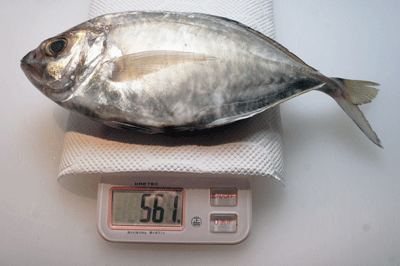
This fish is known for its various nicknames in various parts of Japan, so it is known that there are various names in various places, and the names other than Kaiwari and Hiraaji are Mittki, Simaaji, Kakuaji, Giji, Ginaji, Zenme, Bakera, Pikkariokiaji , Ginaji, Ginukugo, Gintai, Ginbeiaji, Gui, Koshiaji, Kose, Kozen, Shimoaji, Seimai, Nagakamaji, Siimai, Zenmai, Beiken, Beken, Benkei, Meiki, Mejimaaji, Mekkyu, and so on.
At FISH FOOD TIIMES, the principle has been to use the standard Japanese name as a basic for the product name at the beginning. However, this time I decided to use the name of Hiraaji (Silver trevally) to compare with aquaculture Sjimaaji (White trevally).
Hiraaji (Whitefin trevally) is an animal kingdom classification, order Perciformes: family Carangidae: genus Carangoides: C. equula, which is similar in appearance to Sjimaaji (White trevally) of aquaculture of high grade fish.
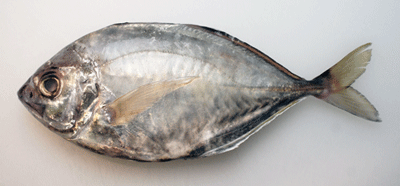
Sjimaaji (White trevally) belongs to order Perciformes: Families Carangidae: Genus Pseudocaranx: P. dentex, both of which are the same families, so you should understand that they are very similar as the underlying image.
Even in English names, White trevally and Whitefin trevally are used in confusion and it is rather close to white, so Hiraji is rather white, so let's keep Hiraji as Whitefin trevally in this month's issue.
Fishes that are similar enough to confuse even English names, but there is a big difference in handling in the market.
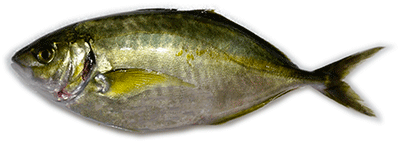
The trading price in the market of cultured White trevally is a high grade fish which must be prepared for around 2,000 yen / kg, depending on freshness, but Whitefin trevally costs 500 yen / kg to 1,000 yen / If you guessed that it's a price of kg, there will be no big madness.
As you can see, Whitefin trevally is usually available at a price less than half the price of White trevally, but then it does not matter whether Whitefin trevally tastes so much. Conversely, "Whitefin trevally is such delicious" is an amazing level.
When removing the skin for Whitefin trevally for sashimi, the silver color of the fat layer is just like Sjimaaji (White trevally) like the underlying image. I think if the Usutsukuri Sashimi of Intro image, to say the lie that it is White trevally, and or not than some people would accept credit.
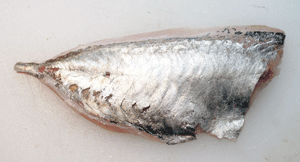
However, in the case of aquaculture White trevally, the body is characterized by whitishness due to the unique oil content of cultured fish, but in the case of Whitefin trevally it is not white body thickened by aquaculture feed , There is moderate fat in a smart body and it has a reddish color, so the difference between them can be distinguished by its color.
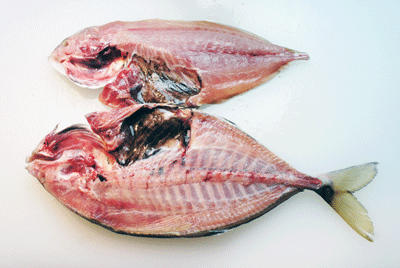
Boiled Whitefin trevally
In terms of its distribution price, the high-grade aquaculture White trevally is basically considered to be limited to uses for sashimi and sushi except for Ryotei and high-class Japanese restaurants, but in the case of Whitefin trevally, its purchase price is as much as White trevally Because it is not expensive, in addition to sashimi and sushi, cooking applications such as boiling and salt-baking can be expanded.

| Cut the body with bone into three equal parts including the head |
|---|
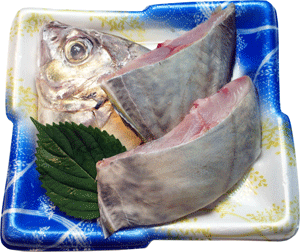
| Whitefin trevally boiled fillet |
|---|
| Process for boiling Whitefin trevally | |
|---|---|
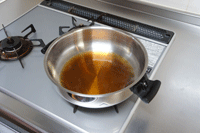 |
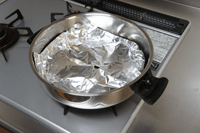 |
1, Dashi Juice 1C, Sugar 5T, Soy Sauce 4T, Mirin 3T, (1C = 1 cup 200 cc, 1 T = 1 tablespoon cup 15 cc) |
4, cover aluminum foil with a hole in the middle |
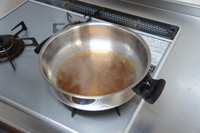 |
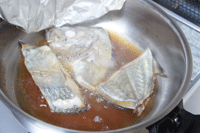 |
| 2, Boil the broth | 5, boil the fish until brown in the whole body |
 |
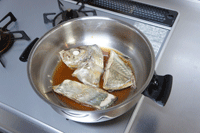 |
| 3, put a fillet of Whitefin trevally in the broth | 6, When boiling, miss crude heat |
 |
|
| Boiling Whitefin trevally | |
Whitefin trevally Usutsukuri sashimi and nigiri sushi
Next, half of the body without middle bone, make the back part sashimi and the abdomen to sushi.
First of all it is a process of Usutsukuri sashimi.
| Whitefin trevally Usutsukuri sashimi process | ||
|---|---|---|
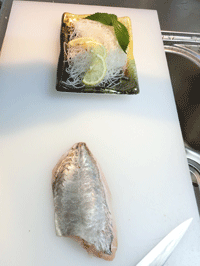 |
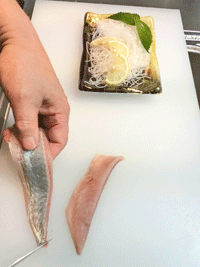 |
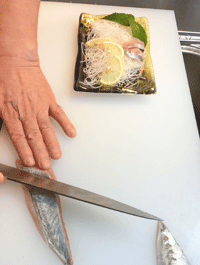 |
| 1, prepare shitami with leather removed | 2. Separate shitami into back and abdomen | 3, Make the back to Usutsukuri sashimi |
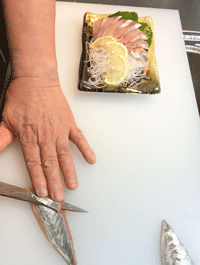 |
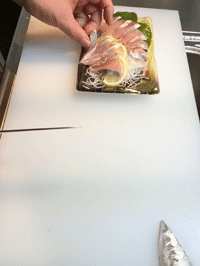 |
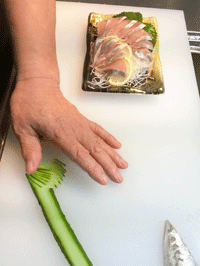 |
| 4, Move to use all the knife blade's length | 5 Serve in two places | 6. Slice the cucumber and make it Ashirai |
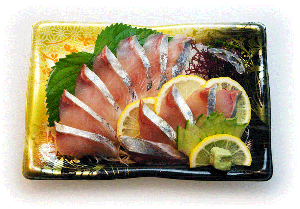 |
||
| Whitefin trevally Usutsukuri Sashimi is completed | ||
The sashimi of Whitefin trevally was completed using the body of the back, so the next nigiri sushi is made using the abdomen.
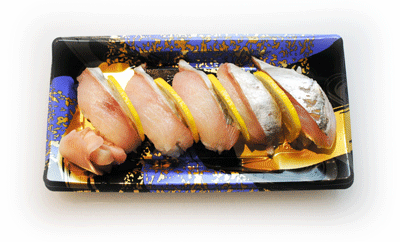
In the commercialization process of Nigiri Sushi, make your body to the left and make it with the skin of the abdomen down. I cut it by Sogitsukuri 's method and secured 5 pieces.
1 Fish It is safe to think that the cost of 560 g of Silver trevally will not be over 300 yen, so if all of the slices, sashimi, nigiri sushi that were commercialized in this issue are supposed to have a selling price of 398 yen, the selling price The total amount is 1,194 yen. Even if the total of the container fee, ashirai, sushi rice fee, etc. is estimated to be 200 yen higher, the total cost including the fish fee will be 500 yen, so the price reduction rate will be calculated as 58.1%.
Some readers think that some people think that "398 yen is too cheap · · ·", but of course this is a temporary story. So I think that readers should play with the simulation "I will make this selling price for myself".
If you make the same commercialization using a cultured White trevally with the same 500 g size and a price of 2,000 yen / kg, if the sum of ashirai and material cost is the same 200 yen, the cost including White trevally will be 1,200 yen , And if it is the same selling price, it means that the profit is zero.
Fish cultivated in this way must pay the price "high price stability" in exchange for the merit of being able to purchase in a stable manner. On the other hand, the natural Whitefin trevally fish should be ready for unstable purchases, but rather it is often obtained at a cheap price because it is not highly appreciated on the market.
It is generally said that the spawning season of Whitefin trevally is autumn and the season is the summer before it, I think that there are readers who feel doubt why in FISH FOOD TIES there is a December issue. The reason is that the Whitefin trevally lives in the relatively southern part of Japan, catches are not sporadic and are not gathered, regardless of the season, there is never any tasty as it is winter so it is a delicious fish throughout the year , Because I thought that winter was the target for dealing withWhitefin trevally.
As Horse mackerel and the same kind of companion live in Japan's waters around 30, Horse mackerel is a very simple one-sided view of the idea of summer, if you follow various kinds of horse mackie variously, it will be 1 year you can see that some of the horse mackerel can be eaten delicious somewhere.
In the past at FISH FOOD TIES, I would like you to refer to other Horse mackerel companions at No. 69 Heisei 21 September issue Giant trevally hiratsukuri sashimi.
Currently cultured white trevally in Japan is treated as a very expensive luxury fish, but the fresh meat of the cultured fish itself is exactly different from the original fish taste. In that respect the natural Whitefin trevally is modest in greasiness, the taste of the tongue when eating, the taste of the natural feel the real taste.
Rather than making Whitefin trevally cheap and not stupid, cultured white trevally is expensive so do not treat it carefully, so you can not be mislead to what the real things are and what is right, such as the reputation of the general public, I want you to be extreme with your eyes and power.
An opinion and the communication are to iinfo@fish food times
Date of updating Dec.1, 2016
